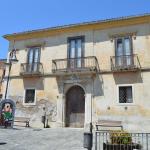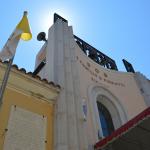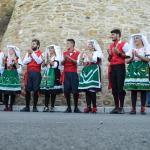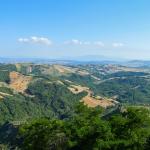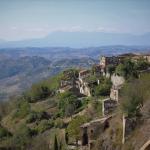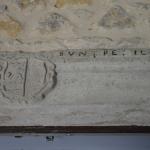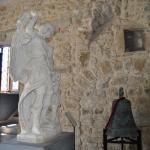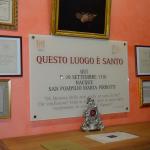The Municipality of Montecalvo Irpino is located within the area of the Cervaro-Miscano Valley. It's a town with 3,475 inhabitants, located 623 metres above sea level, at 60 km from Avellino. The territory extends for 54.01 sq km and the adjoining municipalities are: Apice, Ariano Irpino, Buonalbergo, Casalbore, Castelfranco in Miscano and Ginestra degli Schiavoni.
The etymology of the name, according to some, seems to derive from the Latin mons calvus, or “rocky mountain, devoid of trees”; according to others instead from mons galbus, or “yellow mountain” for the colour of the tuff or of the broom flowers in the area. The inhabitants are called Montecalvesi and Saint Felix is their patron saint.
PLACES OF INTEREST
- Pignatelli Castle - Built in ancient times, today’s plant is the result of the restoration carried out by the last feudal Lords: the Pignatelli, from which it takes its name, and the Carafa family
- Museum of Montecalvese Religiosity and Pompilian Memory - Created thanks to the generosity of the faithful, it houses numerous works of art, objects belonging to the churches of Montecalvo and memories of the presence of Saint Pompilio Maria Pirrotti in his native town
- Trappeto - Ancient village with “cave-houses”, typical rock houses of the Mediterranean, probably built in the Neolithic age, if not as far back as the Upper Paleolithic
- Church of S. Pompilio Maria Pirrotti - Mother Church of Montecalvo and sanctuary dedicated to Saint Pompilio Maria Pirrotti, disciple of Giuseppe Calasanzio, founder of the Pious schools
- Bolle della Malavizza - Small mud volcanoes that generate emissions of gaseous hydrocarbons, especially methane, and a continuous flow in slightly brackish waters
- Bozzuti-Pizzillo Palace - Dating back to the 16th century it belonged to the Bozzuti family, of Neapolitan origin: one of the noblest families of the time
- Caccese Palace - Built in the second half of the 17th century, of the entire building today remains standing only the door consisting of the portal with the central balcony above it
- De Cillis Palace - Dating back to the 18th century, it has a stone portal, richly decorated in floral style, with characteristic small iron balconies
- De Marco Palace - Among the other aristocratic buildings of the town, it dates back to the 19th century and has portals with aristocratic coat of arms in worked stone and characteristic balconies and windows
- Peluso Palace - The original façade, which lasted until 1981, was characterised by a series of eight balconies, but of particular interest today are the cellars, which extend throughout its area
- Other - Church of S. Bartolomeo Apostolo (Saint Bartholomew the Apostle), Church of S. Maria Assunta (Saint Mary of the Assumption), Church of Saint Gaetano da Thiene, Convent of S. Antonio (Saint Anthony) - Oasi Maria Immacolata (Oasis of Immaculate Mary), Abbey Church Contrada Corsano - Church of S. Nicola (Saint Nicholas), Church of the Carmine (Mount Carmel), Church of Maria SS. Regina della Pace (Mary, Queen of Peace), Murals of Via Maddalena, Crociato S. Caterina Hospital
EVENTS
- Millennial Fair of Saint Catherine - Event that takes place in November with three days that combine a focus on the products of agriculture and local crafts, food and wine tastings, music shows, cabaret and cultural routes
- Cicatielli Festival - Food and wine event that takes place in August and focuses on fresh handmade pasta
- Feast of San Pompilio - Celebrations in honour of Saint Pompilio that take place on 19 and 20 August
TYPICAL FOOD AND PRODUCTS
- Bread of Montecalvo PAT - Characterised by a thick crust that encloses a high and compact crumb, inside it has a cavity, proof of its perfect success, whose secret lies in the use of genuine ingredients and respect for the ancient recipe
- Saragolla PAT - One of the oldest varieties of durum wheat grown in Irpinia, it is excellent for baking
- Speuta PAT - Also called “speutona”, it is a grain that corresponds to the triticum spelta, the major spelt used for the production of breads and soups by the Italic populations
- Irpinia Colline dell’Ufita PDO - Extra virgin olive oil deriving largely from the Ravece variety, characterised by a pleasant bitter and spicy taste
- Caciocavallo Silano PDO - Semi-hard cheese, with spun curd, produced with milk from different breeds of cows, including Podolica
FUN FACTS
Legend attributes the origin of the mephitic phenomenon, the Bolle della Malvizza, to the wrath of the gods, who punished a tavern keeper for robbing the wayfarers of the Via Traianea, confining him and his servants in the bowels of the land of the volcanic bubbles: every year, on 15 August the laments of that man are said to still be heard.
The Pacchiana is a typical Montecalvese dress that is worn, even today, by many elderly women or in traditional celebrations (such as Carnival) that refer to the original etymology of the term, or desire for fun, joy, a mixture of smells and flavours, songs and tarantellas that made you think of “pacchia” or fun.
Montecalvo is part of the national association of the Cities of Bread.
HISTORICAL NOTES
Several archaeological finds and the entire village of Trappeto suggest that the first settlements in the territory of Montecalvo Irpino probably arose in the Neolithic age, if not as far back as the Upper Paleolithic.
The first historical information of the town, however, can be found in documents of the year 1000 and it is known that starting from the end of 1300 Montecalvo Irpino was involved in the events of the nearby town of Ariano Irpino.
The earthquake of 1456 deeply damaged the houses of the town and, subsequently, there was an urban expansion outside the now destroyed walls.
Among the domains on the territory, we mention in particular that of the Carafa family: the fief was in fact sold to Alberico Carafa, first Duke of Ariano in 1501, and belonged to this family until the end of the 16th century, when it was conquered by Carlo Gagliardi, and then passed to the Pignatelli family. The latter held the fief of Montecalvo Irpino until 1806, the year of the abolition of feudal rights in southern Italy.
Montecalvo is the good smell of warm, freshly baked bread, a fragrance that stops time and caresses those who seek to lose themselves in its land
Montecalvo Irpino
Piazza Porta della Terra, 1, 83037 Montecalvo Irpino AV, Italia
Featured places
Via Dietro Corte, 83037 Montecalvo Irpino AV, Italia
Although the Castle was built many centuries ago, visitors can still admire the architecture…
Via Bastione, 83037 Montecalvo Irpino AV, Italia
Built thanks to the congregation’s generosity, the Church is home to numerous works of art,…
Via Dietro Carmine, 83037 Montecalvo Irpino AV, Italia
An ancient village of cave homes: typical Mediterranean houses cut out of the rock. They were…
Did you like it? Leave a review
Your opinion is important! It will be visible after approval by the editorial staff.
To post a comment you must be an authenticated user. Log in with Social Login
